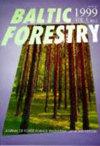深耕造林:对土壤和植被的潜在影响
IF 0.6
4区 农林科学
Q3 FORESTRY
引用次数: 1
摘要
深耕——将土壤有机层(森林地表)和表层矿物层翻转、覆盖或混合到矿物底土中,将上层土壤层埋在更深的土层中,并破坏成土过程——是人工林管理中一个有争议的话题。总的来说,这篇综述文章旨在确定深耕对人工林性质的影响,并借鉴农业部门的经验。本文研究了深耕技术对造林前农用地土壤物理、化学和生物特性、地面植被以及地上和地下树木生物量的主要影响。对已发表文献的分析表明,深耕可以在不同的气候和土壤条件下进行,但它会导致土壤性质和植被的特定位点变化。在造林和再造林过程中,机械整地应遵循土壤可持续管理的要求,避免对环境和生物多样性造成负面影响。基于这一分析,我们提出了可能针对造林场地深耕响应的关键指标,并有助于风险评估,旨在实现可持续森林管理。迄今为止,大多数人工林的机械立地研究都是利用少数针叶树种进行的;因此,扩大实证研究是十分重要的。本文章由计算机程序翻译,如有差异,请以英文原文为准。
Deep soil ploughing for afforestation: a review of potential impacts on soil and vegetation
Deep ploughing—which inverts, covers, or mixes soil organic layer (forest floor) and surface mineral A horizon into the mineral subsoil, burying the upper soil horizon in deeper layers, and disrupting pedogenic processes—is a debatable topic in forest plantation management. Overall, this review article aimed to identify the impacts of deep ploughing on the properties of forest plantations, adapting experiences from the agricultural sector. This paper examines the main impacts of deep ploughing technology on soil physical, chemical, and biological properties, ground vegetation, and tree aboveground and belowground biomass in afforested former agricultural land. Analysis of the published literature shows that deep ploughing can be used under different climatic and soil conditions, but it induces site-specific changes in soil properties and vegetation. Mechanical site preparation during afforestation and reforestation should follow the requirements of sustainable soil management, in order to avoid negative effects on the environment and biodiversity. Based on this analysis, we suggest key indicators that may be specific to deep ploughing responses in afforested sites and can contribute to risk assessment, aimed at achieving sustainable forest management. To date, most studies on mechanical site preparation for forest plantation have been performed using a few conifer tree species; therefore, it is important to expand empirical studies.
求助全文
通过发布文献求助,成功后即可免费获取论文全文。
去求助
来源期刊

Baltic Forestry
农林科学-林学
CiteScore
1.60
自引率
0.00%
发文量
23
审稿时长
>12 weeks
期刊介绍:
The journal welcomes the original articles as well as short reports, review papers on forestry and forest science throughout the Baltic Sea region and elsewhere in the area of boreal and temperate forests. The Baltic Sea region is rather unique through its intrinsic environment and distinguished geographical and social conditions. A temperate climate, transitional and continental, has influenced formation of the mixed coniferous and deciduous stands of high productivity and biological diversity. The forest science has been affected by the ideas from both the East and West.
In 1995, Forest Research Institutes and Universities from Estonia, Latvia and Lithuania
joined their efforts to publish BALTIC FORESTRY.
 求助内容:
求助内容: 应助结果提醒方式:
应助结果提醒方式:


